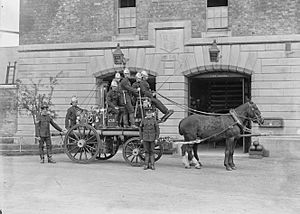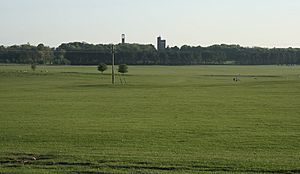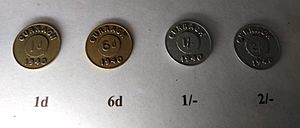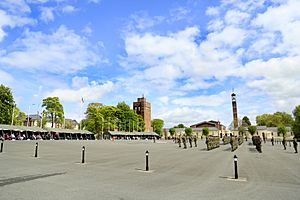Curragh Camp facts for kids
Quick facts for kids Curragh Camp |
|
|---|---|
| Campa an Churraigh | |
| The Curragh, County Kildare | |
 |
|
| Type | Military installation, education & training centre |
| Site information | |
| Controlled by | Irish Defence Forces/Department of Defence |
| Site history | |
| Built | 1855 |
| In use | 17th century – present |
| Garrison information | |
| Garrison |
|
The Curragh Camp (Irish: Campa an Churraigh) is an army base and military college in The Curragh, County Kildare, Ireland. It is the main training centre for the Irish Defence Forces and is home to 2,000 military personnel.
Contents
- History
- Longstanding military heritage
- Crimean War and establishment of Curragh Camp
- Events and routines in 19th-century camp
- Wrens of the Curragh
- Cemetery
- Handover
- Internment and escapes at the Curragh
- Civil War Executions, Deaths and Hunger Strikes
- Internment During The Emergency
- Internment of belligerents and Border Campaign internments
- Modern Curragh Camp
- See also
History
Longstanding military heritage
The Curragh has historically been a military assembly area, owing to the wide expanse of plain. In 1599 Henry Harvey noted "a better place for the deploying of an Army I never beheld." However, the Curragh's history goes further back; it is mentioned in the Annals of the Four Masters that Lóegaire Lorc, the king of Ireland, was slain on the Curragh by Cobthach Cóel Breg.
Richard Talbot, 1st Earl of Tyrconnel chose the Curragh as a muster point for the cause of James II during the Williamite War in Ireland. In 1783, a review of the Irish Volunteers raised to assist in the defence of the country while Great Britain was at war with America held on the Curragh attracted upwards of 50,000 spectators.
It was also a muster point during the 1798 Rebellion and was mentioned in the Irish peasant song The Sean-Bhean bhocht.
Crimean War and establishment of Curragh Camp
There were numerous training camps organised on the Curragh in the nineteenth century including the training of militia to defend the UK during the Napoleonic Wars. However, the first permanent military structures were designed and built from 1855 by British soldiers of the Corps of Royal Engineers in relation to the Crimean War. These structures for 10,000 infantry were wooden in character but the camp did have its own post office, a fire station, ten barracks, two churches, a water pumping station, a court house and a clock tower.
Events and routines in 19th-century camp
In 1861, Queen Victoria and Prince Albert visited to inspect troops, including their son (Edward VII—the then Prince of Wales)—who was serving at the camp. A great troop review was held for the visit and an album of the occasion can be found in the Royal Archive at Windsor Castle.
The first of the "modern" barracks (Beresford Barracks) was built at the camp in 1879, and six new barracks were subsequently constructed through the start of the 20th century. The names of the barracks that were built by the British Army were Ponsonby Barracks, Stewart Barracks, A.S.C Barracks, Engineer Barracks, Gough Barracks and Keane Barracks.
By 1893, the General Officer Commanding (GOC) was Major-General Lord Ralph D. Kerr CB. The garrison was the 1st Battalion Royal Irish Regiment (18th Foot), the 1st Battalion Lancashire Fusiliers (20th Foot), and the 2nd Battalion Worcestershire Regiment (31st Foot). In 1894, the Worcestershires were replaced by the 2nd Battalion the Hampshire Regiment (67th Foot).
The Curragh was a little isolated, which led to stringent regulations about taxi fares. However, the camp was well provided for, with recreational facilities (including, for the officers, hunting with the local gentry), several postal deliveries a day (last collection for England at 11 pm), and a daily Mass for Catholics at the East Church. A gun was fired every day at reveille, at 1 pm and at 9.30 pm.
Wrens of the Curragh
.....
The women lived in the furze-covered areas surrounding the camp, living in holes in banks and ditches with few possessions, in what were known as 'nests'. Their story gained prominence in a series of articles in the Pall Mall Gazette by the English journalist James Greenwood in 1867. His book The Seven Curses of London also contains a chapter on the Wrens.
.....
Cemetery
The Curragh Cemetery has many graves that attest to the British Army presence on the Curragh up to their departure in 1922. The Commonwealth War Graves Commission maintains the graves of 104 servicemen who died at the camp during World War I, which are scattered throughout the cemetery.
Handover
At the time of the passage of the Home Rule Act in 1914, the Camp became the scene of the Curragh incident, where a number of officers proposed to resign rather than enforce Home Rule against the will of the Unionists.
After the Anglo-Irish War (21 January 1919 – 11 July 1921) the British Army handed over Curragh Camp to the Irish Free State Army. The handover took place at 10 o'clock on Tuesday 16 May 1922, when the camp was handed over to a party of Irish troops commanded by Lieutenant General O'Connell. On Monday evening the Union Flag was lowered for the last time. At noon, O'Connell climbed the water tower and hoisted the first Irish tricolour to fly over the Curragh Camp. By tradition the British Army had cut down the flagpole requiring the Irish officers to physically hold the flagpole while the tricolour was raised. Both the Union Flag and the tricolour, which measures 10 ft × 18 ft (3.0 m × 5.5 m) are now preserved in the DFTC.
Internment and escapes at the Curragh
In August 1920 the British Parliament passed the Restoration of Order in Ireland Act 1920 which permitted military authorities to arrest (intern) any Irish person without charge or trial. Under Section 3(6) of the Act, the military established nonpublic court martials in which lawyers (appointed by the military) could be present only in death penalty cases. Inquests of military or police actions were also banned. The Act was not repealed until 1953. In 1921 there were several camps within the Curragh that were used to house internees to include Hare Park and Tintown camps. During the Irish Civil War (June 1922 – May 1923) at least 30 internment camps/prisons existed in Ireland which were used by the newly formed Irish government to hold internees opposed to the Anglo-Irish Treaty. The official internment camp at the Curragh was the Rath camp which held 1,300 internees in 60 wooden army huts on a ten-acre area. The compound was surrounded by ten foot high fences with machine gun towers at each corner.
Multiple escape attempts were made using tunnels and other means to get men out of the Curragh. In April 1921 a tunnel was discovered resulting in the loss of internee privileges. On 11 July 1921 the Irish War of Independence was ended with a truce and all tunneling at the Curragh was suspended. Thirty seven internees who were elected to the new Irish Parliament Dáil Éireann were released from the Curragh to consider the terms of the British peace terms. Because there was no general release of internees escape efforts continued.
On 9 September 1921, between 50 and 70 men escaped from the Hare Park internment camp at the Curragh Camp through a tunnel which took over a month to construct using only knives and spoons. When the tunnel was completed the internees waited for a foggy night and used the noise from an ongoing concert to make their escape. None of the escapees were ever recaptured.
Civil War Executions, Deaths and Hunger Strikes
In December 1922 seven men were executed in the Curragh Military Prison. The Leinster Leader of 23 December 1922 reported that a column of ten men had operated against railways, goods trains and shops in the vicinity of Kildare for some time. Five of them had apparently taken part in an attempt to disrupt communications by derailing engines on 11 December. Two engines had been taken from a shed at Kildare and one of them had been sent down the line into an obstruction at Cherryville, thereby blocking the line. It was also alleged that goods trains had been looted and shops robbed in the locality. The same column was also reported to have taken part in an ambush of Free State troops at the Curragh siding on 25 November.
On 13 December the men were surprised in a dug-out at a farmhouse at Moore's Bridge, on the edge of the Curragh plains, by Free State troops. In the dug-out were ten men, ten rifles, a quantity of ammunition, and other supplies. The men were arrested and conveyed to the Curragh. The proprietress of the farmhouse was also arrested and lodged in Mountjoy Prison.
Controversy surrounds the circumstances of the death of Thomas Behan, one of the men. One version has it that his arm was broken when he was being apprehended and he was subsequently killed by a blow of a rifle butt on the head at the scene of the raid when he was unable to climb on the truck that conveyed the men to the Curragh. The official version was that he was shot when attempting to escape from a hut in which he was detained in the Curragh Camp.
Those that were executed:
- Stephen White (18) Abbey Street, Kildare
- Joseph Johnston (18) Station Road, Kildare
- Patrick Mangan (22) Fair Green, Kildare
- Patrick Nolan (34) Rathbride, Kildare
- Brian Moore (37) Rathbride, Kildare
- James O’Connor (24) Bansha, County Tipperary
- Patrick Bagnall (19) Fair Green, Kildare
A memorial to the executed men can be found in Kildare Town.
During the Irish Civil War, at least two men died in the Curragh Camp while in custody: Owen Boyle on 13 November 1923 and Frank O'Keefe also in 1923 (day of year not stated).
During this time Irish Republican prisoners in Mountjoy Prison began the 1923 Irish Hunger Strikes, protesting being interned without charges or trial and poor prison conditions. The strike quickly spread to other camps and prisons nationwide with the Curragh having the largest number of strikers - 3,390. Four prisoners died in the Curragh as the result of hunger-strikes - Joseph Whitty, aged 19 (while on Hunger strike) on 2 September 1923, Dan Downey (who died in Curragh's Hospital Wing on 10 June 1923 due the effects of an earlier hunger-strike), Denny Barry (while on hunger strike) on 20 November 1923 and Joe Lacey brother of Dinny Lacey who died on 24 December 1923 in the Curragh Camp hospital from complications due to his participation in the 1923 Irish Hunger Strikes.
Internment During The Emergency
During The Emergency (1939-1946), internment of Irish Republicans was again instituted by the Fianna Fáil Government of Éamon de Valera. During the IRA's campaign of bombing and sabotage in England from 1939 to 1940 (the S-Plan) many Irish republicans were deported and interned in the Curragh. IRA members who were arrested by the Garda Síochána were also interned in the Curragh under the Offences against the State Acts 1939–1998 for the duration of hostilities. On 16 December 1940 Irish Republican internee Barney Casey from County Longford was shot and killed by military police in the camp. The camp was usually called Tin Town (Baile an Stáin or an Bhaile Stáin) by the internees. According to historian Tim Pat Coogan, around 2,000 IRA men passed time in the internment camp during the war years.
Also according to Coogan, the years in internment left a great mark on the IRA veterans who remained there for long.
Internment of belligerents and Border Campaign internments
It was also used to intern Allied and Axis personnel who had found themselves in Ireland during World War II. There were three sections in the camp at the time: one each for the IRA, Allied airmen and German mariners and airmen. British personnel were interned at the Curragh, whereas US personnel were repatriated due to an agreement between the Irish and US governments, though one US citizen, Roland Wolfe, whose nationality had been stripped by the US Government for fighting with the British (in No. 133 Squadron RAF) prior to the US entry to the war, was also interned. The Allied and Axis "internees" at the Curragh were not strictly contained, and were allowed to attend social events outside the detention camp. There was a film made about the World War II detention camp, in 1998, called "The Brylcreem Boys".
The Curragh Internment Camp held members of the Irish Republican Army (IRA) during its 1956-62 Border Campaign. On 2 December 1958, 14 internees escaped from the Camp. The Camp contained approximately 150 men, the last of the internees were eventually released and the internment camp was closed on 11 March 1959.
Modern Curragh Camp
The Curragh Camp is now home to the Defence Forces Training Centre of the Irish Defence Forces, housing the Command and Staff School, the Cadet School, the Infantry School, the Combat Support College, the Combat Services Support College, the Equitation School, a logistics base, a supply and services unit, and the United Nations School.
The Curragh Camp has seen modernisation in late 20th and early 21st century, with billet blocks being refurbished and dining and messing facilities upgraded for all ranks. Other developments include a workshop complex and a large garage for MOWAG Piranha APCs.
The tallest building in the Curragh is the fire station, where the army maintain a modern fire fighting service.
See also
- Curragh incident
- Defence Forces Training Centre (DFTC)
- List of Irish military installations
$





